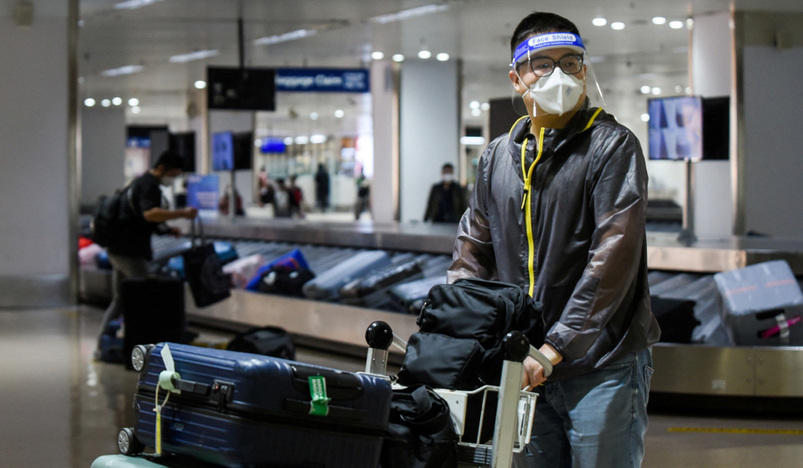
Passenger
The Philippine Embassy in Qatar reminded the Filipino community that fully vaccinated international arriving passengers were exempted from RT-PCR test protocols in the Philippines.
In an advisory, it said that the Filipinos aged 18 and above who have received at least one COVID-19 booster shot, aged 12 to 17, and ages 12 below, accompanied by parents are no longer required to present a negative RT-PCR test upon arrival in the Philippines.
Fully-vaccinated Filipinos and foreigners who will enter the Philippines beginning May 30 are no longer required to present a negative reverse transcription-polymerase chain reaction (RT-PCR) test upon arrival in the Philippines.
In an online press briefing, acting Deputy Presidential Spokesperson and Communications Undersecretary Michel Kristian Ablan said the new protocol was contained in the resolution approved by the Inter-Agency Task Force for the Management of Emerging Infectious Diseases (IATF-EID) on Thursday.
Under IATF-EID Resolution 168, inbound passengers need not present an RT-PCR test, on conditions that they are 18 years old and above, and have at least one booster shot against the coronavirus disease 2019 (Covid-19).
Also exempted from the pre-departure RT-PCR requirement are those aged 12 to 17 who have received two Covid-19 vaccine shots, as well as those aged below 12 who are accompanied by fully vaccinated or boosted parents or guardians.
Travel insurance requirement lifted
The IATF-EID, according to its latest resolution, has also lifted the travel insurance requirement for incoming passengers.
The updated Covid-19 protocols included under IATF-EID Resolution 168 allows travelers to enter the Philippines sans the need to secure travel insurance.
Originally, they can only enter the country, if they obtain travel insurance for Covid-19 treatment costs from reputable insurance providers, with a minimum coverage of USD35,000 for the duration of their stay in the country.
Fully-vaccinated travelers, according to the new IATF-EID resolution, are still mandated to present acceptable proof of vaccination and passports valid for a period of at least six months at the time of their arrival.
For temporary visitors, they must have valid tickets for their return journey to the port of origin or next port of destination not later than 30 days from date of arrival.
The acceptable proofs of Covid-19 vaccination include the World Health Organization International Certificate of Vaccination and Prophylaxis, VaxCertPH, national or state digital certificate of foreign country accepting VaxCertPH, and other proof of vaccination permitted by the IATF-EID.
Unvaccinated passengers
Travelers who are unvaccinated or partially unvaccinated or have unverified vaccination status must present a negative RT-PCR test taken within 48 hours or a negative laboratory-based rapid antigen negative test result administered and certified by a healthcare professional taken within 24 hours prior to the date and time of departure from the country of origin or first port of embarkation in a continuous travel to the Philippines.
They are also required to undergo facility-based quarantine until the release of their negative RT-PCR test taken on the fifth day from the date of their arrival in the Philippines. They must also undergo home quarantine until their 14th day in the country.
The relaxed protocol likewise applies to Filipinos traveling to the Philippines, the Department of Tourism (DOT) said Friday.
“We are glad that the propositions we have worked on have been approved by the IATF-EID and are now up for implementation. As we make it more convenient for tourists to visit the country, the public’s health and safety will remain the DOT’s priority,” Tourism Secretary Bernadette Romulo-Puyat said.
“The DOT sees this development as a win for the local tourism industry as welcoming more tourists in the country will yield more revenues for our MSMEs (micro, small and medium enterprises) and restore more jobs and livelihoods in the sector,” she added.
Although travel insurance is no longer required, it is still highly encouraged for arriving passengers, the DOT added. All types of vaccination certificates, regardless of country of origin, will also be accepted.
Based on the latest DOT data, a total of 517,516 foreigners visited the Philippines from February 10 to May 25, 2022.
A bulk of foreign tourists, totaling 104,589 came from the United States, followed by South Korea with 28,474, and Canada with 24,337.
Australian, British/English, and Japanese tourists came next on the list with 23,286; 20,846; and 13,373 respectively.
Other foreign visitors to the Philippines during the early months of the year included Vietnamese, Singaporeans, Malaysians, Italians, Irish and French.
Romulo-Puyat said the DOT looks forward to an uptick in tourist arrivals in the coming weeks following the further easing of entry requirements into the country.
.jpg)
Qatar Secures Place Among the World's Top 10 Wealthiest Nations
.jpg)
Hamad International Airport Witnesses Record Increase in Passenger Traffic

Saudi Arabia: Any visa holder can now perform Umrah

What are Qatar's Labour Laws on Annual Leave?
Leave a comment